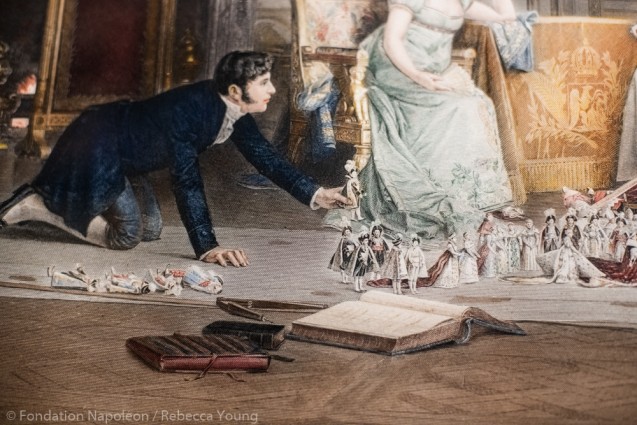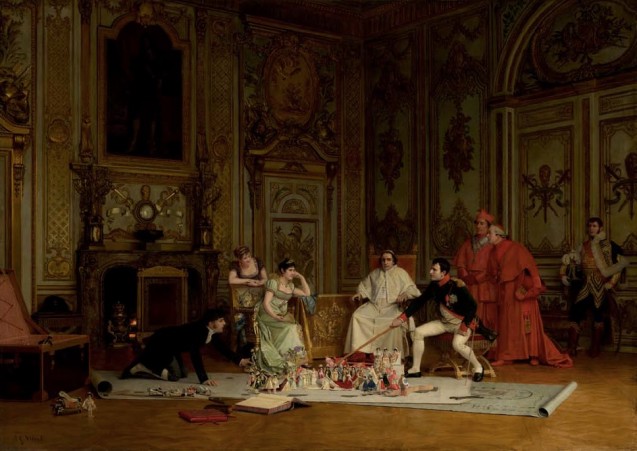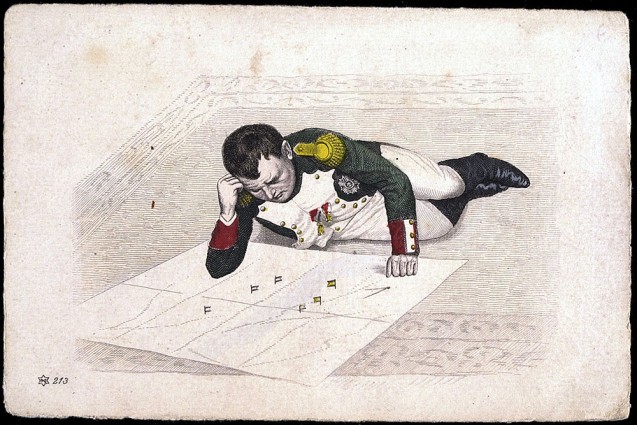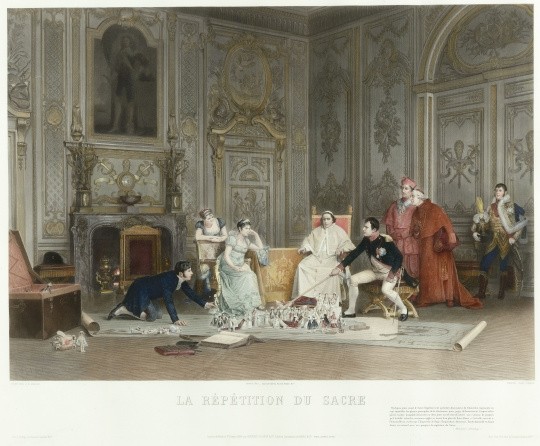A footnote in the memoirs[3] of L.-F.-J. Bausset, (Former Préfet of the Imperial Palace), describes in detail the circumstances of the event here depicted:
“Eight days before that of the coronation, the Emperor asked [Isabey] to provide seven drawings representing the seven ceremonies to take place in the metropolitan church, since the rehearsals could not take place at Nôtre-Dame because of the presence of the numerous workers who were busy preparing the decorations. To ask for seven drawings each of which would include more than a hundred participants, at such short notice, was really asking the impossible. But Napoleon would never accept such an excuse. The word “impossible” had long since been erased from his dictionary… At that moment, M. Isabey’s fortunate and fertile imagination provided him with a most original idea… He replied confidently, to the great astonishment of the Emperor, that within 48 hours his orders would be executed. On his way home, he went to the toy stores and bought as many petits bons hommes en bois [little wooden dolls] that he could find, of the kind that are usually given to children to play with… He dressed them up using paper of the same colour as the costume of each personality that was to play a part in the ceremonies, made a plan of Notre-Dame at the same scale as that of the little dolls, and, two days later, went to Napoleon who quickly asked to see the drawings. “Sire, I have better than that”, replied Isabey. He unrolled his scale drawing and placed upon it the characters that were supposed to take part in the first ceremony, and whose names he had written at the base of each. This first moment was the reception beneath the canopy at the entrance to the church. The Emperor was so delighted, that he immediately summoned all those that were supposed to contribute to the radiance of this great occasion… The rehearsals took place in the Emperor’s salon on a large table. Only one ceremony, more complicated than the others, required a proper rehearsal. That one took place in the Galerie de Diane at the Tuileries [Palace], using a plan drawn in white on the parquet. Isabey had dressed his dolls as tastefully as possible, and by his talent rescued the ridiculous nature of his 3-dimensional drawings. The clergy, the ladies, the princesses, the Emperor, even the Pope, everyone was dressed as precisely and appropriately as could be […]”
According to Bausset, the simulations of the various stages in the ceremony took place in the “salon de l’Empereur on a large table”. However, in Vibert’s reconstruction of the event, the action takes place directly on the floor in what is now the Salle du Trône at the Château de Fontainebleau. In 1808, Napoleon decided to create a throne room from what was formerly la Chambre du Roi [the King’s Chamber, the heart of the palace] where, to this day, a few royal emblems subsist (According to Jean Vittet, curator at the Château de Fontainebleau, this room was indeed known at that time as the “salon de l’Empereur”). In the engraving, a portrait of Louis XIII can be seen above the fireplace. Bausset does not specify at which residence these miniature rehearsals took place, but Napoleon was indeed staying at Fontainebleau a week before the Sacre; he was there when Pope Pius VII arrived on 25 November and the following day a grand dinner was held there in the Pope’s honour. On 28th, they returned to Paris to the Tuileries.[4]

In the engraving Isabey is shown kneeling on the floor somewhat comically organising the dolls on the plan of Notre-Dame whilst Napoleon, wearing one of his famous Chasseur colonel uniforms, leans over from his seat giving directions with the help of a long wooden baton. Bausset’s account does not mention by name all the others present on that occasion. Vibert’s picture includes Josephine, who appears a little bored, and Hortense, who is more amused than her mother. Seated beside Napoleon is Pope Pius VII in a posture almost identical to that of Jacques-Louis David’s 1805 portrait of him (which was commissioned by Napoleon), with the notable exception of the shifty-looking sideways glance in Napoleon’s direction, perhaps because the Emperor appears to have just knocked over a group of clergy with his stick. Standing behind Napoleon are two cardinals, Fesch and Antonelli, and, to their left, General Junot. The effect produced is reminiscent of a mise en abyme[5], since each of the principal characters in the painting is reproduced in miniature at the centre of the scene.
Whilst Bausset’s account of the incident[6] should be regarded with some caution[7], (this is probably not an eye-witness account, after all, he was not “Préfet du Palais” until 1805), it is quite plausible that Isabey proposed this solution to facilitate the final arrangements for the key phases of the ceremony of the Sacre. Indeed, as Cyril Lécosse points out, it was a common practice for artists in the 18th century to construct scale models with decors and figurines in order to test their compositions. The painter Jacques-Louis David is known to have done so for his monumental depiction of the Sacre[8]. The dispositive concocted by Isabey would have been the perfect tool allowing Napoleon to choreograph precisely and control single-handedly in advance the entire “mise-en-scene” of his own consecration and coronation, whose “raison d’être” was to reinforce his legitimacy as Emperor (he had already been named Emperor in May 1804)[9], just as the chosen ceremonial objects and iconography that accompanied the ritual did so. (For more on this symbolism, see our file on Ingres’s painting Napoleon on his Imperial throne). In her memoirs, Josephine’s femme de chambre Mademoiselle d’Avrillon recalls the arrival of the cortège at Notre-Dame for the Sacre, where she was present, attending Josephine:
“[…] I attached the Empress’s imperial cloak, and the princesses adjusted their costumes. When everything was ready, the cortège entered the cathedral, where each person put himself, according to his rank, in the place which had been given to him: it was exactly like a piece of theatre, since all the roles had been studied in advance. There had even been at the Palace, several rehearsals using a 3-dimensional model of the Sacre that M. Isabey had made for the Emperor. The Messieurs masters of ceremonies who, I might say, were playing the roles of prompters, whose job it was to remind each of the characters who were playing an important role in the ceremony where they were supposed to go, what they had to do[…]”[10].

This image, inspired by an event which probably happened, is itself of course totally imagined and staged. Formally it even resembles a scene on a theatre stage in the way it is organised. The spectator’s viewpoint is equivalent to that of an audience situated just behind the invisible fourth wall of the theatrical space. The realistic treatment of the original painting (pictured above) is almost photographic; the rendering of the pictorial space, supported by a wealth of naturalistic details and some carefully chosen protagonists, persuasively tempts the viewer to suspend disbelief.
Given Napoleon’s obsessive and controlling personality, it is easy to imagine him fine-tuning the movements and positions of everyone – his family, the clergy, the members of his court – maybe even giving instructions on where to place the anonymous bundle of foreign “ambassadors” (on the bottom left of the picture), just as he would do when preparing for battle using his maps and the coloured pins representing the regiments[11]. Vibert’s late-19th century image of Napoleon rehearsing his Sacre, cannot but remind us of the great strategist at work.

Bibliography :
Cyril Lécosse, Jean-Baptiste Isabey (1767-1855), l’artiste et son temps, 2012
Luke Dalla Bona, The collection of the Museo Napoleonico, Havana, Cuba (2021)
Footnotes
[1] now at the Museo Napoléonico La Habana, Cuba. A copy also exists in a private collection.
[2] This is the translation of the text beneath the engraving: “A few days before the Sacre, Napoleon wanted Isabey, the Cabinet draftsman, to present him with seven watercolours representing the main phases of the Ceremony in order to evaluate the final appearance and the positions. Isabey, unable to execute such a task within two days, bought a hundred or so dolls which he dressed according to the approved costumes, and armed with a scale plan of Notre Dame, returned to Fontainebleau and, in front of the Emperor, the Pope, the Empress, Hortense, Fesch, Antonelli and Junot, proceeded to rehearse the coronation with his dolls. (Sources: Memoirs of Isabey[sic])”. Note: there are no Memoirs by Isabey.
(Original French: “Quelques jours avant le Sacre, Napoléon veut qu’Isabey, dessinateur du Cabinet, lui présente en sept aquarelles les phases principales de la Cérémonie pour juger définitivement l’aspect et les places. Isabey, incapable d’exécuter en deux jours un tel travail, achète une centaine de poupées qu’il habille selon les costumes réglés, se munit d’un plan de Notre Dame à l’échelle, revient à Fontainebleau et, devant l’Empereur, le Pape, l’Impératrice, Hortense, Fesch, Antonelli et Junot, donne au naturel, avec ses poupées, la répétition du sacre. (Sources: Mémoires d’Isabey[sic])”)
[3] L.-F.-J. de Bausset, Mémoires anecdotiques sur l’intérieur du palais et sur quelques événemens de l’Empire. Tome 1 / , depuis 1805 jusqu’au 1er mai 1814, pour servir à l’histoire de Napoléon. https://gallica.bnf.fr/ark:/12148/bpt6k111603p/f15.item.texteImage
[4] Jean Tulard, Louis Garros, Itinéraire de Napoléon au jour le jour 1769-1821.
[5] French term derived from heraldry which refers to a formal technique, a favourite of artists, in which an image contains a smaller copy of itself
[6] Bausset is not the only person to mention the anecdote. It appears in several other memoirs including those of: Anais de Bassainville (1862), and Mlle d’Avrillon, Première femme de chambre de l’impératrice. Mémoires sur la vie privée de Joséphine, sa famille et sa cour (1833), and Mme de Rémusat.
[7] According to the Nouvelle Bibliographie Critique des Mémoires sur l’époque Napoléonienne, by Jean Tulard, p35, Bausset’s Mémoires have “certainly been rewritten by teinturiers including perhaps [Honoré de] Balzac”.
[8] Cyril Lécosse’s 2012 thesis Jean-Baptiste Isabey (1767-1855), l’artiste et son temps, Vol I p 327
[9] On 18 May 1804, the Sénat conservateur proclaimed that the government of the Republic had been handed over to an Emperor and that Napoleon Bonaparte had become the “Empereur des Français” under the name of “Napoléon 1er”. See https://www.napoleon.org/en/history-of-the-two-empires/articles/napoleonic-legitimacies-and-the-proclamation-of-empire/
[10] Mlle d’Avrillon, op cit. p.74. Concerning the reliability of these memoirs, Jean Tulard writes that they were “penned by Villemarest, according to Valérie Masuyer, Queen Hortense judged the memoirs of Mlle Avrillon (sic) quite precise, the “femme de chambre having had to collaborate with Villemarest. These memoirs are to Josephine what those of Constant are to Napoleon; they present the same interest and require the same caution.” (Nouvelle Bibliographie Critique des Mémoires sur l’époque Napoléonienne, p 74.)
[11] In Scheltens: Souvenirs d’un vieux soldat belge de la garde imperiale (1880), “Une grande carte était déployé sur le parquet […] A genoux, sur cette carte, Napoléon plantait des épingles à tête de cire d’Espagne de deux différentes couleurs” (“A large map was spread out on the floor […] Napoleon, kneeling on this map, was planting pins with sealing wax of two different colours”)


